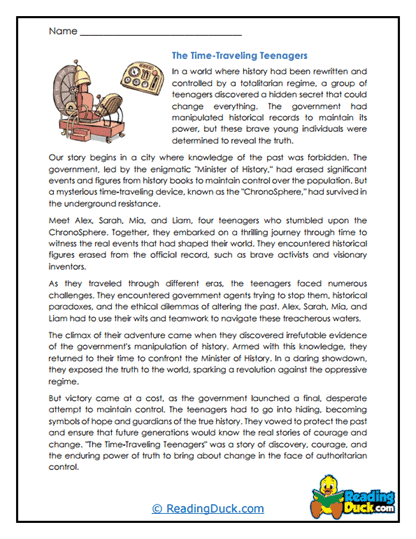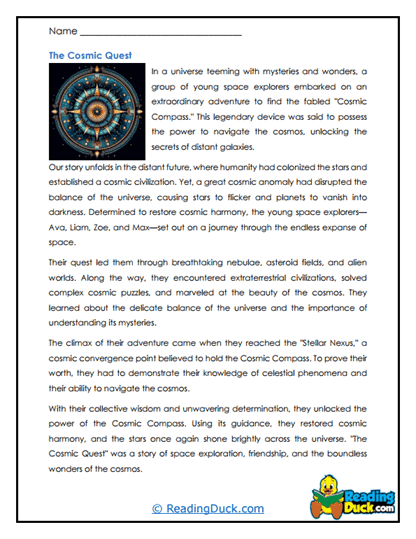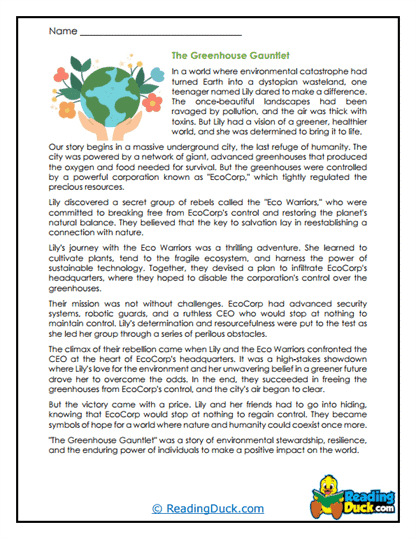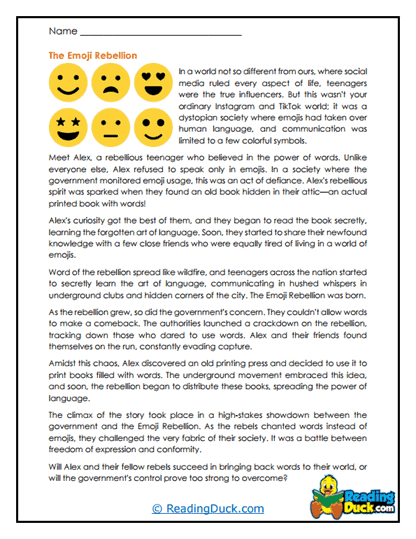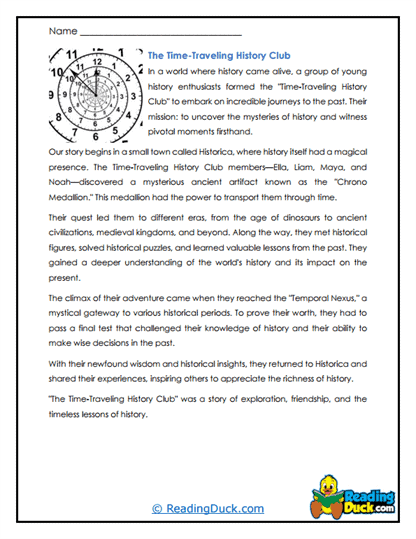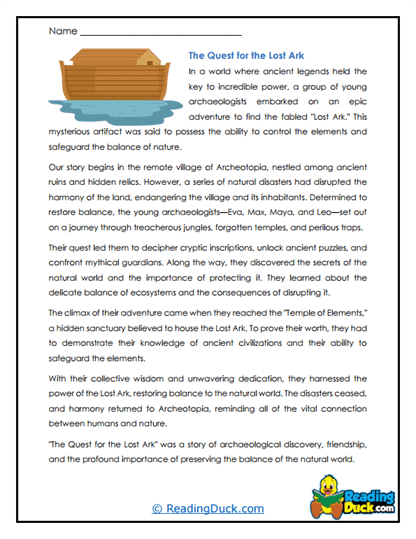Dystopian Worksheets
About Our Dystopian Worksheets
Our Dystopian Worksheets are thoughtfully crafted to immerse students in the rich, thought-provoking world of dystopian fiction. Each worksheet set contains a carefully selected reading passage that embodies the key elements of dystopian literature, accompanied by a variety of multiple-choice, short-answer, and open-ended questions. These questions are designed to guide students through an in-depth exploration of the text, helping them develop essential skills in reading comprehension, critical analysis, and creative thinking.
All of our worksheets are presented in PDF format, making them simple to download, view, and print for classroom or individual use. For added convenience, each worksheet set includes a downloadable answer key, allowing educators to easily assess student performance and provide targeted feedback.
Whether students are engaging with these worksheets independently or as part of group activities, they provide a flexible and engaging tool for examining dystopian fiction. By focusing on the genre’s key themes and narrative techniques, these worksheets help students not only understand dystopian stories but also reflect on the larger social and ethical questions these works raise.
Unpacking the Dystopian Genre
Dystopian fiction is a genre that explores societies where oppression, inequality, and totalitarian control have led to a degraded or nightmarish reality for the inhabitants. Often set in a future where societal or environmental catastrophes have reshaped civilization, dystopian stories examine the consequences of extreme political, social, or technological systems. These works are known for their exploration of themes like surveillance, loss of individual freedoms, societal collapse, and dehumanization.
One of the key narrative techniques in dystopian fiction is world-building, where the author creates a detailed and often chilling vision of a future world. These settings often exaggerate existing societal trends, such as environmental destruction, authoritarian rule, or technological overreach, to reflect real-world anxieties. Another hallmark of dystopian stories is their focus on characters who must navigate these oppressive societies, either by conforming, resisting, or attempting to escape.
Dystopian fiction serves an important role in the broader landscape of fiction because it forces readers to reflect on current societal issues and consider the potential consequences of unchecked power, environmental neglect, or the loss of personal freedoms. These stories provoke readers to think critically about the systems and structures that govern their own world, making the genre a powerful tool for encouraging social awareness and ethical reflection.
The Dystopian Worksheets help students engage with these themes by guiding them through close readings of the text and prompting them to analyze the social and political issues at the heart of the story. By examining how dystopian authors construct their worlds and characters, students can better understand the cautionary messages these stories often convey.
A Balanced Approach to Learning
Our Dystopian Worksheets are structured to provide a balanced approach to learning, ensuring that students can explore the genre through both comprehension-based and critical thinking exercises. Each worksheet set begins with a reading passage that reflects a key aspect of dystopian fiction, followed by a variety of questions designed to engage students on multiple levels.
- Multiple-choice questions are used to check for basic comprehension, ensuring that students can recall key plot points, character motivations, and significant world-building details. These questions provide a foundation for deeper analysis by helping students familiarize themselves with the essential elements of the story.
- Short-answer questions prompt students to explore specific aspects of the text, such as how the dystopian world influences character behavior or the way certain settings reflect the society’s larger issues. These questions encourage students to look beyond the surface and analyze how the author’s choices shape the narrative.
- Open-ended response prompts offer students the opportunity to dive deeper into the text’s themes and moral questions. These questions may ask students to reflect on the consequences of the dystopian society presented, draw parallels to real-world issues, or even imagine how the story might change if a key decision had been different.
For example, after reading a passage from a dystopian story about a society ruled by technology, students might be asked to reflect on how the lack of personal privacy affects the characters' relationships and sense of self. This kind of analysis helps students understand the broader social commentary often present in dystopian fiction.
Encouraging Critical Thinking and Exploration
The Dystopian Worksheets are designed to go beyond basic comprehension and foster critical thinking and exploration of the genre’s deeper themes. Dystopian fiction often raises questions about morality, power, and human nature, making it a perfect platform for encouraging students to think critically about both the text and its broader implications.
One way these worksheets promote critical thinking is through open-ended questions that ask students to reflect on the ethical dilemmas and societal critiques within the story. For example, students may be asked to consider whether the characters in the dystopian world are justified in their actions, or to discuss the role of rebellion in oppressive societies. These questions challenge students to examine not only the narrative but also the moral and philosophical questions embedded in dystopian fiction.
Additionally, the worksheets often prompt students to draw connections between the dystopian world and real-life issues. For instance, students might explore how themes like government surveillance, environmental decay, or the rise of artificial intelligence in the story mirror current global concerns. This allows students to engage with the text in a way that extends beyond fiction and into real-world reflection.
Supporting Collaborative and Independent Learning
Our Dystopian Worksheets are versatile tools that can be easily adapted for both individual study and group-based learning activities. This flexibility ensures that the worksheets are suitable for a variety of classroom settings, whether students are working on their own or engaging in collaborative discussions.
In a group setting, these worksheets can serve as the basis for peer reviews, group debates, or collaborative projects. For example, after reading a dystopian passage, students might be asked to work together to imagine an alternative outcome to the story or debate the fairness of the societal rules in the dystopian world. These activities encourage students to share their ideas, listen to differing perspectives, and work together to build a deeper understanding of the text.
For individual learners, the worksheets offer a structured approach to self-guided exploration of dystopian fiction. Students can progress through the multiple-choice questions to solidify their comprehension before moving on to the more open-ended, reflective prompts that encourage deeper analysis. This self-paced approach allows students to engage with the material at their own speed, making the worksheets an ideal resource for homework assignments, remote learning, or independent study.
Inspiring Creative Thinking and Interpretation
In addition to encouraging critical analysis, our Dystopian Worksheets inspire creative thinking and interpretation. Dystopian fiction is a genre that thrives on imaginative world-building, and the worksheets invite students to engage with the creative possibilities of these worlds.
Many of the open-ended questions included in the worksheets challenge students to think creatively about the dystopian scenarios presented in the reading passage. For example, students might be asked to imagine an alternate ending to the story, envision what life would be like for different characters in the same society, or rewrite a scene from another character’s perspective. These activities encourage students to explore the story from new angles and develop their own unique interpretations of the text.
Furthermore, the creative exercises help students reinforce their understanding of the genre’s core themes. By reimagining dystopian worlds and exploring different outcomes, students not only develop their creative writing skills but also gain a deeper appreciation for the narrative structures and moral questions that define dystopian fiction.
Conclusion
Our Dystopian Worksheets provide a comprehensive and engaging resource for students and educators alike, offering a well-rounded approach to exploring the unique and thought-provoking genre of dystopian fiction. With a balance of multiple-choice, short-answer, and open-ended questions, these worksheets encourage students to think critically, engage creatively, and reflect on the broader societal and ethical questions presented in dystopian stories.
Whether used in a classroom setting for group discussions or as an independent learning tool, these worksheets help students develop essential skills in reading comprehension, literary analysis, and creative interpretation. By guiding students through the core elements of dystopian fiction and encouraging them to think critically about the world around them, these worksheets not only enhance their understanding of the genre but also foster a deeper connection to literature and its real-world implications.
